
The Battle of Neerwinden saw a Republican French army led by Charles François Dumouriez attack a Coalition army commanded by Prince Josias of Saxe-Coburg-Saalfeld. The Coalition army of the Habsburg monarchy together with a small contingent of allied Dutch Republic troops repulsed all French assaults after bitter fighting and Dumouriez conceded defeat, withdrawing from the field. The French position in the Austrian Netherlands swiftly collapsed, ending the threat to the Dutch Republic and allowing Austria to regain control of its lost province. The War of the First Coalition engagement was fought at Neerwinden, located 57 kilometres (35 mi) east of Brussels in present-day Belgium.

The Battle of Quatre Bras was fought on 16 June 1815, as a preliminary engagement to the decisive Battle of Waterloo that occurred two days later. The battle took place near the strategic crossroads of Quatre Bras and was contested between elements of the Duke of Wellington's Anglo-allied army and the left wing of Napoleon Bonaparte's French Armée du Nord under Marshal Michel Ney. The battle was a tactical victory for Wellington, but because Ney prevented him going to the aid of Blucher's Prussians who were fighting a larger French army under the command of Napoleon Bonaparte at Ligny it was a strategic victory for the French.
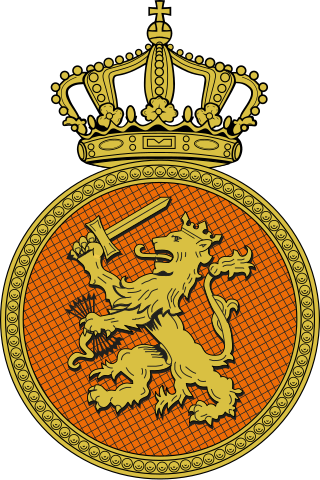
The Royal Netherlands Army is the land branch of the Netherlands Armed Forces. Though the Royal Netherlands Army was raised on 9 January 1814, its origins date back to 1572, when the Staatse Leger was raisedm making the Dutch standing army one of the oldest in the world. It fought in the Napoleonic Wars, World War II, the Indonesian War of Independence, and the Korean War and served with NATO on the Cold War frontiers in West-Germany from the 1950s to the 1990s.
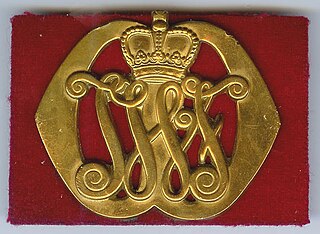
The Regiment Infantry Prins Johan Willem Friso is a line infantry regiment of the Royal Netherlands Army. Named after Johan Willem Friso of Orange-Nassau, it is the oldest and most senior regiment in the current order of battle. The regiment currently serves in the mechanized infantry role as 44 Armoured Infantry Battalion as part of 43 Gemechaniseerde (Mechanized) Brigade.
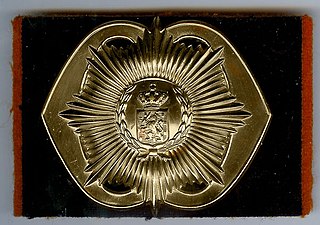
The Regiment van Heutsz is a line infantry regiment of the Royal Netherlands Army. The regiment was named after J.B. van Heutsz, a former Governor-General of the Dutch East Indies, and was formed on July 1, 1950. It is notable for its service as part of the United Nations force sent to fight during the Korean War. It is still operational and has served tours as part of the ISAF Afghanistan Mission.

The Land Component is the land branch of the Belgian Armed Forces. The King of the Belgians is the commander in chief. The current chief of staff of the Land Component is Major-General Pierre Gérard.

Bernhard Lucas Emmanuel, Prince of Orange-Nassau, van Vollenhoven is a Dutch entrepreneur and a member of the Dutch royal family.

The German invasion of the Netherlands, otherwise known as the Battle of the Netherlands, was a military campaign part of Case Yellow, the Nazi German invasion of the Low Countries and France during World War II. The battle lasted from 10 May 1940 until the surrender of the main Dutch forces on 14 May. Dutch troops in the province of Zeeland continued to resist the Wehrmacht until 17 May when Germany completed its occupation of the whole country.
Bernhard is a given name and family name.

Multi National Base Tarin Kot is a former International Security Assistance Force (ISAF) installation, used after the Netherlands Armed Forces' departure by the Afghan National Army. The base was located on the outskirts of Tarinkot, the capital of Uruzgan Province in southern Afghanistan.
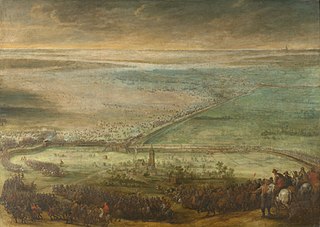
The Battle of Kallo was a major field battle fought from 20 to 21 June 1638 in and around the forts of Kallo and Verrebroek, located on the left bank of the Scheldt river, near Antwerp, during the second phase of the Eighty Years' War. Following the symbolic recovery of Breda during the 1637 campaign, the Dutch Republic agreed with the French Crown, with whom it had allied in 1635, to besiege a major city in the Spanish Netherlands during the 1638 campaign. The commander of the Dutch States Army, Frederick Henry of Orange, planned an approach over Antwerp from the two sides of the Scheldt. Count William of Nassau-Siegen was entrusted to land in the Spanish-controlled Waasland region, west of Antwerp, to seize the forts of Kallo and Verrebroek, along with several other key fortifications, to invest Antwerp from the west. In the meantime, Frederick Henry would advance on the opposite bank to complete the blockade of the city while the armies of France invaded the Spanish Netherlands from the south to oblige the Spanish Army of Flanders to divide its forces.

The Regiment Carabiniers Prins Boudewijn – Grenadiers is an infantry regiment in the Land Component of the Belgian Armed Forces. The regiment is a part of the Motorized Brigade. This regiment is a Dutch speaking unit.

The 11 Air Assault Brigade is the rapid light infantry brigade of the Royal Netherlands Army, focused on conducting air assault operations. Troops of the brigade are qualified to wear the maroon beret upon completion of the demanding training course, those qualified as military parachutists wear the appropriate parachutist wings. The brigade was handed the name '7 December' when the First Division 7 December was disbanded in 2004.
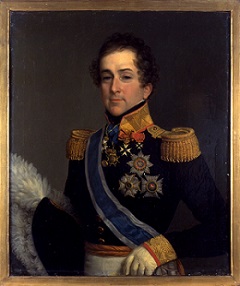
Willem Frederik count of Bylandt or Bijlandt was a Dutch lieutenant-general who as a major-general commanded a Belgian-Dutch infantry brigade at the Battle of Quatre Bras and the Battle of Waterloo.

Prince Bernhard of Lippe-Biesterfeld was a German nobleman who was Prince consort of the Netherlands from 6 September 1948 to 30 April 1980 as the husband of Queen Juliana. They were the parents of four children, including Beatrix, who was Queen of the Netherlands from 1980 to 2013.

The King's Dutch Brigade was a brigade of the British army, organised by the Hereditary Prince of Orange out of former officers and lower ranks of the former Dutch States Army, deserters from the Batavian army, and mutineers from the Batavian fleet that had surrendered to the Royal Navy in the Vlieter Incident during the Anglo-Russian invasion of Holland in 1799, but fully in British service and paid for by the British government. It was commissioned on 21 October 1799 and was initially in garrison on the Isle of Wight and in Lymington. It saw service in Ireland in 1801, and afterwards back to the Isle of Wight and Lymington as well as to the Channel Islands of Jersey and Guernsey. The orders for the brigade to be disbanded were issued on 12 July 1802, as agreed in the Treaty of Amiens of 25 March 1802.
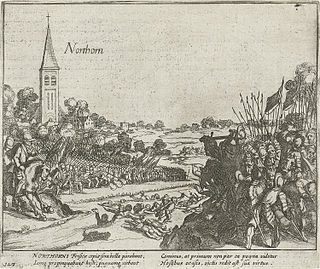
The Battle of Noordhorn, fought on 30 September 1581, was a pitched battle of the Dutch Revolt, fought between a Spanish army commanded by Colonel Francisco Verdugo – consisting of Walloon, German, Spanish, and Albanian soldiers – and a Dutch States rebel army under the Englishman John Norreys – comprising English, Scottish, Dutch, and Walloon troops – in the province of Groningen. In 1580, the Dutch stadtholder of Groningen, George van Lalaing, Count of Rennenberg, had shifted its allegiance from the Dutch to the Spanish side. This opened a new front at the back door of the Dutch Republic, forcing the States-General to dispatch forces to the north. That year the Dutch, under the leadership of John Norreys, succeeded in relieving the town of Steenwijk. In July 1581, Rennenberg died and was replaced by the Spaniard Francisco Verdugo, whose arrival in Groningen with reinforcements changed the situation. On 30 September Verdugo forced Norreys to give battle using a strategy of attrition.

The current structure of the Royal Netherlands Army is as follows:

The Regiment Huzaren Prinses Catharina-Amalia is a cavalry regiment of the Royal Netherlands Army. The regiment was formed in late 2020 through the amalgamation of three other Dutch cavalry regiments that, at the time, existed in suspension - the Regiment Huzaren Prins Alexander, Regiment Huzaren Van Sytzama and Regiment Huzaren Prins van Oranje. The new regiment took over the operation of the army's remaining main battle tanks, as well as two of the army's ceremonial units, the Cavalry Escort and the Mounted Units Regimental Band.

The Binnenlandse Strijdkrachten, fully the Nederlandse Binnenlandse Strijdkrachten, was a government-sanctioned union of Dutch resistance groups during the German occupation of the Netherlands in World War II, which had hardly cooperated until then.




















